Chaojun Xiao
MiniCPM4: Ultra-Efficient LLMs on End Devices
Jun 09, 2025Abstract:This paper introduces MiniCPM4, a highly efficient large language model (LLM) designed explicitly for end-side devices. We achieve this efficiency through systematic innovation in four key dimensions: model architecture, training data, training algorithms, and inference systems. Specifically, in terms of model architecture, we propose InfLLM v2, a trainable sparse attention mechanism that accelerates both prefilling and decoding phases for long-context processing. Regarding training data, we propose UltraClean, an efficient and accurate pre-training data filtering and generation strategy, and UltraChat v2, a comprehensive supervised fine-tuning dataset. These datasets enable satisfactory model performance to be achieved using just 8 trillion training tokens. Regarding training algorithms, we propose ModelTunnel v2 for efficient pre-training strategy search, and improve existing post-training methods by introducing chunk-wise rollout for load-balanced reinforcement learning and data-efficient tenary LLM, BitCPM. Regarding inference systems, we propose CPM.cu that integrates sparse attention, model quantization, and speculative sampling to achieve efficient prefilling and decoding. To meet diverse on-device requirements, MiniCPM4 is available in two versions, with 0.5B and 8B parameters, respectively. Sufficient evaluation results show that MiniCPM4 outperforms open-source models of similar size across multiple benchmarks, highlighting both its efficiency and effectiveness. Notably, MiniCPM4-8B demonstrates significant speed improvements over Qwen3-8B when processing long sequences. Through further adaptation, MiniCPM4 successfully powers diverse applications, including trustworthy survey generation and tool use with model context protocol, clearly showcasing its broad usability.
Ultra-FineWeb: Efficient Data Filtering and Verification for High-Quality LLM Training Data
May 08, 2025Abstract:Data quality has become a key factor in enhancing model performance with the rapid development of large language models (LLMs). Model-driven data filtering has increasingly become a primary approach for acquiring high-quality data. However, it still faces two main challenges: (1) the lack of an efficient data verification strategy makes it difficult to provide timely feedback on data quality; and (2) the selection of seed data for training classifiers lacks clear criteria and relies heavily on human expertise, introducing a degree of subjectivity. To address the first challenge, we introduce an efficient verification strategy that enables rapid evaluation of the impact of data on LLM training with minimal computational cost. To tackle the second challenge, we build upon the assumption that high-quality seed data is beneficial for LLM training, and by integrating the proposed verification strategy, we optimize the selection of positive and negative samples and propose an efficient data filtering pipeline. This pipeline not only improves filtering efficiency, classifier quality, and robustness, but also significantly reduces experimental and inference costs. In addition, to efficiently filter high-quality data, we employ a lightweight classifier based on fastText, and successfully apply the filtering pipeline to two widely-used pre-training corpora, FineWeb and Chinese FineWeb datasets, resulting in the creation of the higher-quality Ultra-FineWeb dataset. Ultra-FineWeb contains approximately 1 trillion English tokens and 120 billion Chinese tokens. Empirical results demonstrate that the LLMs trained on Ultra-FineWeb exhibit significant performance improvements across multiple benchmark tasks, validating the effectiveness of our pipeline in enhancing both data quality and training efficiency.
APB: Accelerating Distributed Long-Context Inference by Passing Compressed Context Blocks across GPUs
Feb 17, 2025Abstract:While long-context inference is crucial for advancing large language model (LLM) applications, its prefill speed remains a significant bottleneck. Current approaches, including sequence parallelism strategies and compute reduction through approximate attention mechanisms, still fall short of delivering optimal inference efficiency. This hinders scaling the inputs to longer sequences and processing long-context queries in a timely manner. To address this, we introduce APB, an efficient long-context inference framework that leverages multi-host approximate attention to enhance prefill speed by reducing compute and enhancing parallelism simultaneously. APB introduces a communication mechanism for essential key-value pairs within a sequence parallelism framework, enabling a faster inference speed while maintaining task performance. We implement APB by incorporating a tailored FlashAttn kernel alongside optimized distribution strategies, supporting diverse models and parallelism configurations. APB achieves speedups of up to 9.2x, 4.2x, and 1.6x compared with FlashAttn, RingAttn, and StarAttn, respectively, without any observable task performance degradation. We provide the implementation and experiment code of APB in https://github.com/thunlp/APB.
Densing Law of LLMs
Dec 05, 2024



Abstract:Large Language Models (LLMs) have emerged as a milestone in artificial intelligence, and their performance can improve as the model size increases. However, this scaling brings great challenges to training and inference efficiency, particularly for deploying LLMs in resource-constrained environments, and the scaling trend is becoming increasingly unsustainable. This paper introduces the concept of ``\textit{capacity density}'' as a new metric to evaluate the quality of the LLMs across different scales and describes the trend of LLMs in terms of both effectiveness and efficiency. To calculate the capacity density of a given target LLM, we first introduce a set of reference models and develop a scaling law to predict the downstream performance of these reference models based on their parameter sizes. We then define the \textit{effective parameter size} of the target LLM as the parameter size required by a reference model to achieve equivalent performance, and formalize the capacity density as the ratio of the effective parameter size to the actual parameter size of the target LLM. Capacity density provides a unified framework for assessing both model effectiveness and efficiency. Our further analysis of recent open-source base LLMs reveals an empirical law (the densing law)that the capacity density of LLMs grows exponentially over time. More specifically, using some widely used benchmarks for evaluation, the capacity density of LLMs doubles approximately every three months. The law provides new perspectives to guide future LLM development, emphasizing the importance of improving capacity density to achieve optimal results with minimal computational overhead.
Sparsing Law: Towards Large Language Models with Greater Activation Sparsity
Nov 04, 2024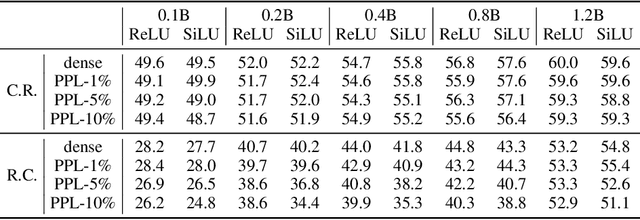



Abstract:Activation sparsity denotes the existence of substantial weakly-contributed elements within activation outputs that can be eliminated, benefiting many important applications concerned with large language models (LLMs). Although promoting greater activation sparsity within LLMs deserves deep studies, existing works lack comprehensive and quantitative research on the correlation between activation sparsity and potentially influential factors. In this paper, we present a comprehensive study on the quantitative scaling properties and influential factors of the activation sparsity within decoder-only Transformer-based LLMs. Specifically, we propose PPL-$p\%$ sparsity, a precise and performance-aware activation sparsity metric that is applicable to any activation function. Through extensive experiments, we find several important phenomena. Firstly, different activation functions exhibit comparable performance but opposite training-time sparsity trends. The activation ratio (i.e., $1-\mathrm{sparsity\ ratio}$) evolves as a convergent increasing power-law and decreasing logspace power-law with the amount of training data for SiLU-activated and ReLU-activated LLMs, respectively. These demonstrate that ReLU is more efficient as the activation function than SiLU and can leverage more training data to improve activation sparsity. Secondly, the activation ratio linearly increases with the width-depth ratio below a certain bottleneck point, indicating the potential advantage of a deeper architecture at a fixed parameter scale. Finally, at similar width-depth ratios, we surprisingly find that the limit value of activation sparsity varies weakly with the parameter scale, i.e., the activation patterns within LLMs are insensitive to the parameter scale. These empirical laws towards LLMs with greater activation sparsity have important implications for making LLMs more efficient and interpretable.
Enhancing Legal Case Retrieval via Scaling High-quality Synthetic Query-Candidate Pairs
Oct 09, 2024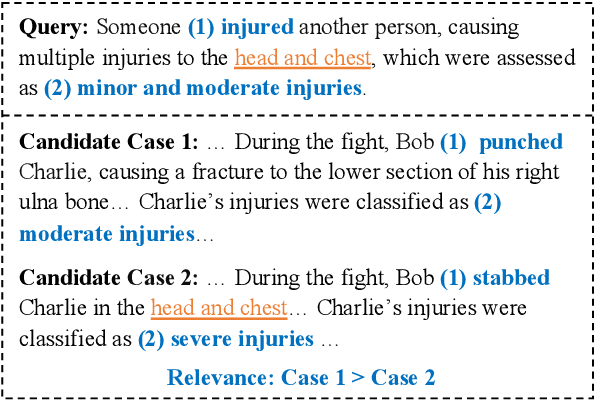

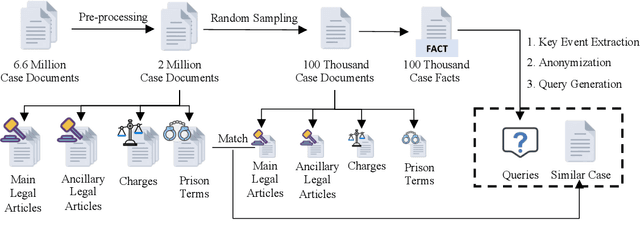

Abstract:Legal case retrieval (LCR) aims to provide similar cases as references for a given fact description. This task is crucial for promoting consistent judgments in similar cases, effectively enhancing judicial fairness and improving work efficiency for judges. However, existing works face two main challenges for real-world applications: existing works mainly focus on case-to-case retrieval using lengthy queries, which does not match real-world scenarios; and the limited data scale, with current datasets containing only hundreds of queries, is insufficient to satisfy the training requirements of existing data-hungry neural models. To address these issues, we introduce an automated method to construct synthetic query-candidate pairs and build the largest LCR dataset to date, LEAD, which is hundreds of times larger than existing datasets. This data construction method can provide ample training signals for LCR models. Experimental results demonstrate that model training with our constructed data can achieve state-of-the-art results on two widely-used LCR benchmarks. Besides, the construction method can also be applied to civil cases and achieve promising results. The data and codes can be found in https://github.com/thunlp/LEAD.
Exploring the Benefit of Activation Sparsity in Pre-training
Oct 04, 2024
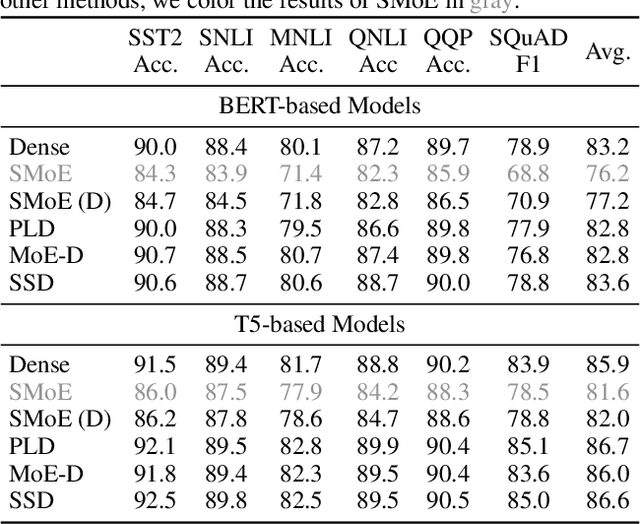
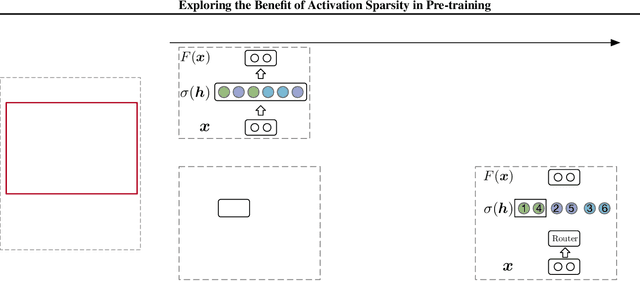
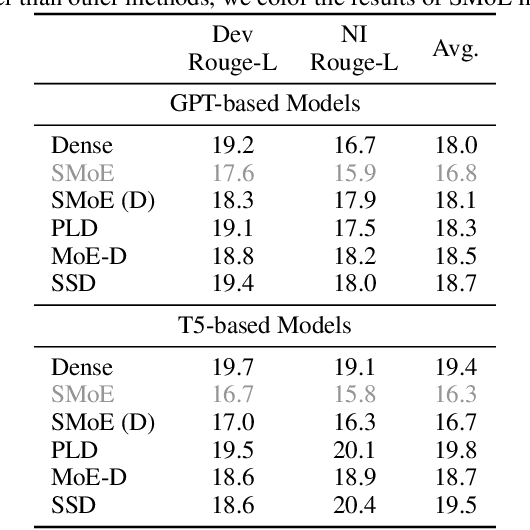
Abstract:Pre-trained Transformers inherently possess the characteristic of sparse activation, where only a small fraction of the neurons are activated for each token. While sparse activation has been explored through post-training methods, its potential in pre-training remains untapped. In this work, we first study how activation properties change during pre-training. Our examination reveals that Transformers exhibit sparse activation throughout the majority of the pre-training process while the activation correlation keeps evolving as training progresses. Leveraging this observation, we propose Switchable Sparse-Dense Learning (SSD). SSD adaptively switches between the Mixtures-of-Experts (MoE) based sparse training and the conventional dense training during the pre-training process, leveraging the efficiency of sparse training and avoiding the static activation correlation of sparse training. Compared to dense training, SSD achieves comparable performance with identical model size and reduces pre-training costs. Moreover, the models trained with SSD can be directly used as MoE models for sparse inference and achieve the same performance as dense models with up to $2\times$ faster inference speed. Codes are available at https://github.com/thunlp/moefication.
Locret: Enhancing Eviction in Long-Context LLM Inference with Trained Retaining Heads
Oct 02, 2024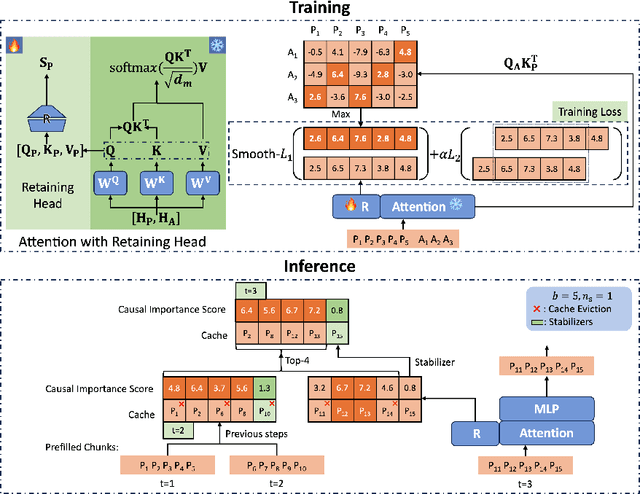
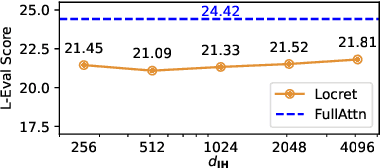
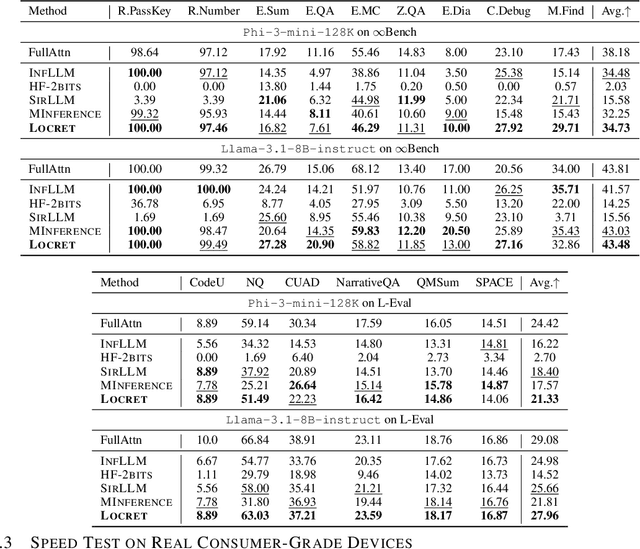

Abstract:Large language models (LLMs) have shown remarkable advances in supporting long-context comprehension and processing tasks. However, scaling the generation inference of LLMs to such long contexts incurs significant additional computation load, and demands a substantial GPU memory footprint to maintain the key-value (KV) cache of transformer-based LLMs. Existing KV cache compression methods, such as quantization, face memory bottlenecks as context length increases, while static-sized caches, such as eviction, suffer from inefficient policies. These limitations restrict deployment on consumer-grade devices like a single Nvidia 4090 GPU. To overcome this, we propose Locret, a framework for long-context LLM inference that introduces retaining heads to evaluate the causal importance of KV cache units, allowing for more accurate eviction within a fixed cache size. Locret is fine-tuned on top of the frozen backbone LLM using a minimal amount of data from standard long-context SFT datasets. During inference, we evict low-importance cache units along with a chunked prefill pattern, significantly reducing peak GPU memory usage. We conduct an extensive empirical study to evaluate Locret, where the experimental results show that Locret outperforms the recent competitive approaches, including InfLLM, Quantization, SirLLM, and MInference, in terms of memory efficiency and the quality of generated contents -- Locret achieves over a 20x and 8x KV cache compression ratio compared to the full KV cache for Phi-3-mini-128K and Llama-3.1-8B-instruct. Additionally, Locret can be combined with other methods, such as quantization and token merging. To our knowledge, Locret is the first framework capable of deploying Llama-3.1-8B or similar models on a single Nvidia 4090 GPU, enabling 128K long-context inference without compromising generation quality, and requiring little additional system optimizations.
From MOOC to MAIC: Reshaping Online Teaching and Learning through LLM-driven Agents
Sep 05, 2024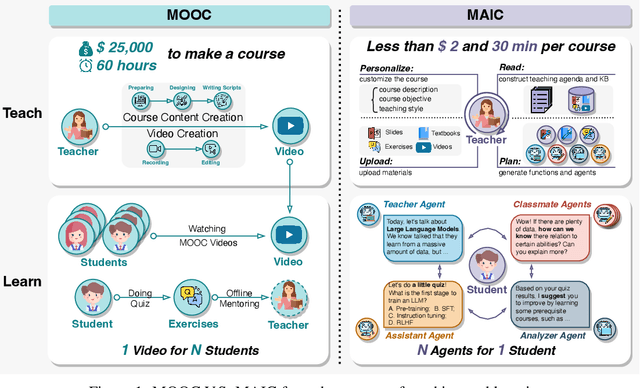

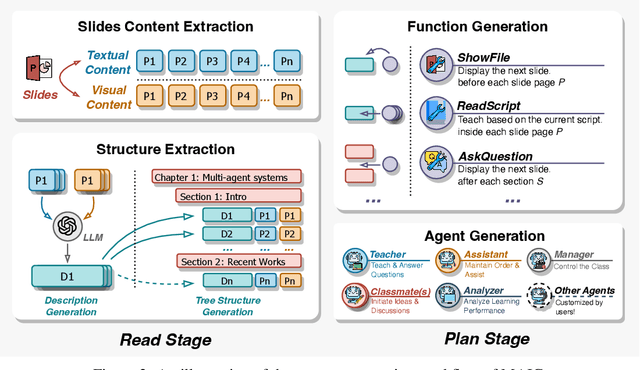
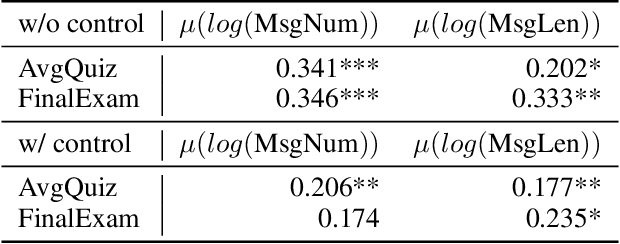
Abstract:Since the first instances of online education, where courses were uploaded to accessible and shared online platforms, this form of scaling the dissemination of human knowledge to reach a broader audience has sparked extensive discussion and widespread adoption. Recognizing that personalized learning still holds significant potential for improvement, new AI technologies have been continuously integrated into this learning format, resulting in a variety of educational AI applications such as educational recommendation and intelligent tutoring. The emergence of intelligence in large language models (LLMs) has allowed for these educational enhancements to be built upon a unified foundational model, enabling deeper integration. In this context, we propose MAIC (Massive AI-empowered Course), a new form of online education that leverages LLM-driven multi-agent systems to construct an AI-augmented classroom, balancing scalability with adaptivity. Beyond exploring the conceptual framework and technical innovations, we conduct preliminary experiments at Tsinghua University, one of China's leading universities. Drawing from over 100,000 learning records of more than 500 students, we obtain a series of valuable observations and initial analyses. This project will continue to evolve, ultimately aiming to establish a comprehensive open platform that supports and unifies research, technology, and applications in exploring the possibilities of online education in the era of large model AI. We envision this platform as a collaborative hub, bringing together educators, researchers, and innovators to collectively explore the future of AI-driven online education.
Configurable Foundation Models: Building LLMs from a Modular Perspective
Sep 04, 2024



Abstract:Advancements in LLMs have recently unveiled challenges tied to computational efficiency and continual scalability due to their requirements of huge parameters, making the applications and evolution of these models on devices with limited computation resources and scenarios requiring various abilities increasingly cumbersome. Inspired by modularity within the human brain, there is a growing tendency to decompose LLMs into numerous functional modules, allowing for inference with part of modules and dynamic assembly of modules to tackle complex tasks, such as mixture-of-experts. To highlight the inherent efficiency and composability of the modular approach, we coin the term brick to represent each functional module, designating the modularized structure as configurable foundation models. In this paper, we offer a comprehensive overview and investigation of the construction, utilization, and limitation of configurable foundation models. We first formalize modules into emergent bricks - functional neuron partitions that emerge during the pre-training phase, and customized bricks - bricks constructed via additional post-training to improve the capabilities and knowledge of LLMs. Based on diverse functional bricks, we further present four brick-oriented operations: retrieval and routing, merging, updating, and growing. These operations allow for dynamic configuration of LLMs based on instructions to handle complex tasks. To verify our perspective, we conduct an empirical analysis on widely-used LLMs. We find that the FFN layers follow modular patterns with functional specialization of neurons and functional neuron partitions. Finally, we highlight several open issues and directions for future research. Overall, this paper aims to offer a fresh modular perspective on existing LLM research and inspire the future creation of more efficient and scalable foundational models.
 Add to Chrome
Add to Chrome Add to Firefox
Add to Firefox Add to Edge
Add to Edge